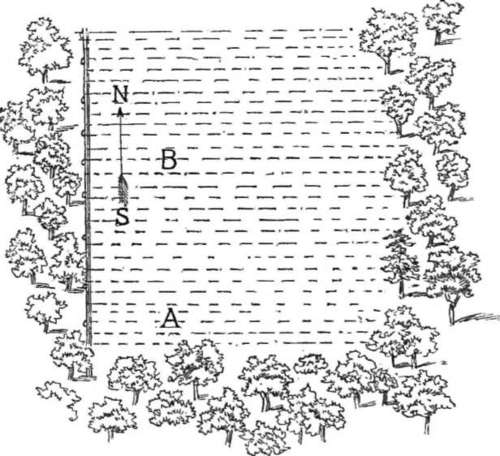Facts
Description
This section is from the book "Trees And Tree-Planting", by James S. Brisbin. Also available from Amazon: Trees and Tree Planting.
Facts
All this, some will say, is theory. But Kansas in 1874 gave us, along the line of the M. K. and T. E. E., and in other parts of the state, some important facts in this direction. There are many parts of the state where corn was an entire failure. In a few localities corn matured a fair crop, even in exposed conditions. And there were other localities where corn yielded a crop only under very favorable conditions of culture and protection. It is these localities that are most interesting to us now. Space will permit at present the presentation of only a few of these cases reported to me by Eobert Mihken, H. E. Yan Deman, and others.
We have here represented a corn-field, Isaac Smith's, fourteen miles south of Emporia. A B, corn-field, at 0 the road passes through the timber, leaving an opening for the wind. As a consequence no corn matured near the road on either side. The timber south of B was very heavy, and the yield of corn in that part of the field was forty bushels to the acre; while south of A the timber was much fighter, and as a result the yield of corn was not more than twenty bushels to the acre.

The figure below represents a field of corn reported by Mr. Van Deman, situated on the Neosho River, two miles south of Neosho Falls. At A the field of corn was forty bushels to the acre. Further north, at B, beyond the influence of the southern protection, the corn dried up and was much fighter.

The following figure represents a corn-field north and east of an orchard eighteen years old, trees large and closely planted, Linn County, Kansas. Reported by M. F. Leasure as yielding, in 1874, twice the corn of any other land upon the farm, though in ordinary seasons the corn is not as good as from some other parts of the farm.

Another case is that of B. F. Leonard, ten miles east of Emporia. Mr. Leonard had two fields in corn last year on land cleared of timber, and at least one half mile from the prairie on the south. ' He raised,' says Mr. Mihken, 'the largest and heaviest corn I saw in 1874.' Corn from this field took the premium at the Linn County Fair, and was good enough for any season. The yield was sixty bushels per acre. Several other cases have been reported, with a careful attention to all incidental circumstances, so as to leave no doubt in regard to the direct influence of protection upon the corn crop of that immediate vicinity. In one case the corn was good for fifteen or twenty rods north of the timber, while beyond that line there was little or no corn. In another county, where a medium crop was made without protection, the lightest corn is reported on the southern side of the fields, where most exposed to the winds. The above cases are only given as examples of those which have been reported. They are facts which the practical farmer and orchardist in Kansas need to study. If we doubt the deductions of science, we certainly ought not to be slow in accepting the testimony of experience. Tree-planters have long advocated shelter-belts, for they know the deductions of science are in their favor, and the testimony of experience has been brought across the ocean to prove these positions; but the disasters of 1874 have brought out the experienced testimony of hundreds in Kansas. These can say, at least, that we know whereof we affirm when we report that in our experience shelter-belts have exerted a controlling influence on farm crops.
It is time for the farmers of Kansas to look at the practical side of this question.
The whole matter of protection needs to be thoroughly studied. Let the whole subject be carefully systematized with reference to the broadest results. We need to consider at large what to plant, when to plant, in what way to combine and extend our shelter-belts; how the interests of neighborhoods, towns, and even counties, run together in this work; how the interest of every property-holder may be concerned in this matter; what may be justly claimed of our state and government to encourage the work; and, lastly, how to reach and gain the attention of the great mass of farmers on this question. These points are too broad and too important for a brief discussion."
Continue to:
